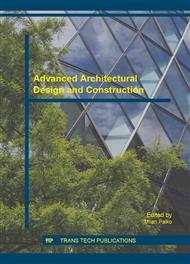p.139
p.146
p.152
p.159
p.165
p.171
p.177
p.183
p.189
Selection of Material Base of External Wall in Term of Thermal Performance
Abstract:
Nowadays, the residential buildings are highly demands in every aspect. From technical point of view, it is necessary to observe required thermal performance of buildings structures, which are included in the Slovak technical standard STN 73 0540-2, 31:a) boundary conductance (thermal resistance) b) the internal surface temperature of the building structure c) the amount of condensed and evaporated water vapor in building structures for a year d) heat absorption capacity of floor structure e) annual energy needs for heating f) thermal stability of locality [1]Accomplishment of those requirements should ensure thermal comfort in the living rooms of the building. Thermal comfort is commonly defined as a feeling of satisfaction with the thermal aspects of environment, in which the person does not feel hot or cold. This definition means, that the user does not wish hotter or colder environment. [2]. This feeling of thermal comfort can only be achieved, by optimal design of the entire building, in which they will not neglect the broader relationships as: orientation or building location on the land. Of course it is very important to design cover construction well, as thermal performance view as material base view, where should we make provision for thermal loss, phase change, thermal accumulation etc.
Info:
Periodical:
Pages:
165-170
Citation:
Online since:
January 2016
Authors:
Price:
Сopyright:
© 2016 Trans Tech Publications Ltd. All Rights Reserved
Share:
Citation:


